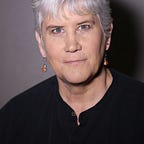Crossing the Border, Jewish at the Boundaries
A Finding Judaism Essay.
“You know, I was never Christian. I was born Jewish.”
“I know, and your momma and your ema and your grandparents were all born Jewish,” I said, deep in conversation with my 6-year-old stepdaughter, Shaya.
“I, on the other hand, am the only one in my family that is Jewish,” I added.
“Because you turned Jewish,” she piped up.
Three years ago — before I knew anything about this amazing child or her mother, who I fell in love with, or her twin brother and the 9-year-old twins — I decided to bicycle across the United States with Hazon, the largest Jewish sustainable agriculture and food justice organization in the country. At that time, I had been living a Jewish life for about 12 years, but I hadn’t seriously thought about converting, in part because I was participating in Jewish communities in Hartford, CT, where my full participation was welcome even though I had not officially converted.
Then I bicycled 3,000-plus miles across the country as part of a diverse Jewish community, where I was welcome but started to feel even more strongly: “This is my community. This is where I feel at home. I need to make official my connection to Judaism.”
After the nine-week ride, I was in transition, moving from Connecticut back in with my Mormon parents before settling in Spokane, WA. I designed a reading program for myself, focused on books about the edges — the places where Judaism meets the world.
The Jew in the Lotus is about Rodger Kamenetz’ poetic rediscovery of his own Jewish identity in Buddhist India while visiting the Dalai Lama with another diverse group of Jews. The Dalai Lama invited the group to talk about how an exiled community can maintain its spiritual identity and culture.
In Shalom Japan: A Sabra’s Five Years in the Land of the Rising Sun, Shifra Horn and Ora Cummings talk about an Israeli’s experience in Japan. This book was particularly interesting to me because I served as a Mormon missionary in Japan in what seems now to have been a lifetime ago.
Eugene L. Pogany describes the intersection of Judaism and Catholicism in a Hungarian family in In My Brother’s Image: Twin Brothers Separated by Faith after the Holocaust. Eugene’s father and his father’s twin brother were born Jewish, but when they were 6, the boys’ parents converted to Catholicism, one because of political and professional expedience, and the other one because she found solace there. Eugene’s father returned to Judaism while the twin brother went on to become a Catholic priest. The book is ultimately about the boys’ relationship within the larger context of religion and a world at war.
In Beyond the Pale, Elana Dykewomon sets her book of fiction in the early 20th century and follows the lives of two women born in a Russian Jewish settlement (the “pale”) who then immigrate to the United States. Elana explores the margins where Jews meet Russians, where Russian Jews meet Americans, and where lesbians meet the world.
My childhood was spent growing up as a foreigner — a gringo in Bogota, Colombia; an American during the Vietnam war in Brussels, Belgium; a gaijin or literally “outside person” in Tokyo, Japan. A third-culture kid, I navigated the borders and the boundaries. I learned how to watch and listen and find my place in what at first seemed foreign.
Bicycling across the U.S., we stopped in about 25 different Jewish communities, where I saw how many people like me seeking a more engaging way to interact with one another, with the land, and with the universe. I found my way home and decided to claim my place — and so I “turned Jewish” on a sunny day last summer in a lake near Spokane.
I further claimed my place a few weeks ago when my partner, Rabbi Elizabeth Goldstein and I, went to Svara’s Queer Talmud Camp in Lake Delton, WI. At Svara, a traditionally radical yeshiva, anyone can study Talmud and the words of the marginalized rabbis of the first century. You don’t have to be a man. You don’t have to be straight. You don’t have to be fluent in Hebrew. You don’t even have to be Jewish. You just have to be willing to do the work to study the significance of this Jewish text in your life today. The friendships, the setting, the food, and the line-by-line teasing out of meaning from the Talmud was transformative. What fascinated me was the number of converts to Judaism. More than 10 percent of the 60 students had found their way across the border into the rich, diverse, and wonderful world of Judaism.
In nature, the creatures and plants that can survive at the margins are the strong ones — the ones who help their species survive or give birth to a new species that can thrive under current conditions. There are hardy bacteria that live at the edge between hot and cold waters. There are porcupines that reside in the desert, and deer that thrive between the still green forest and the honking horns of bustling urban areas. And there are people, like me, who adapt and transform on the margins by crossing boundaries and coming home.
Originally published at https://reformjudaism.org on July 24, 2015.
